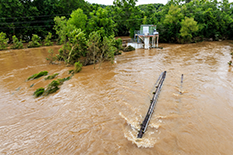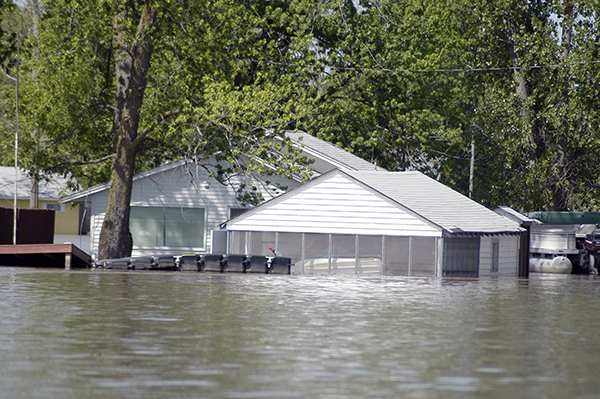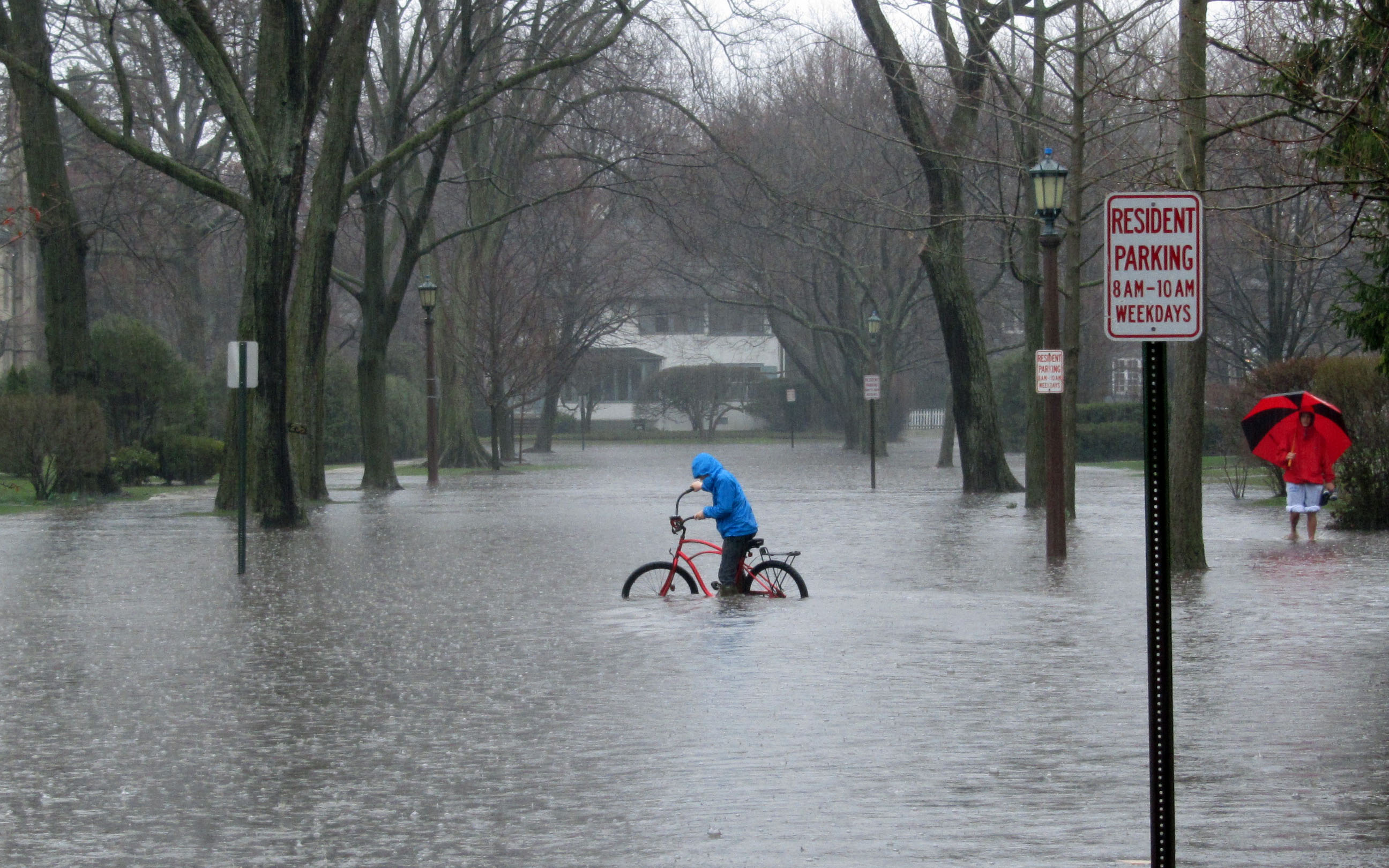News Story
UMD Researchers Address Water Management, Sustainability Challenges

Image courtesy of FEMA
According to the World Health Organization (WHO), today, nearly 800 million people across the globe—one-tenth of the world's total population—lack access to safe water.
Day in and day out, thousands of men, women and children in developing countries trek miles in search of water, often settling for unsanitary waterways as their source for survival. As a result, 34 million peopel die each year due to water-related diseases, which represents the leading cause of disease and death around the world, the WHO says.
In efforts to contribute to the worldwide search for a solution, Civil and Environmental Engineering (CEE) Assistant Professor Baoxia Mi is researching new techniques for high-performance water treatment.
Mi, who also directs the University of Maryland's (UMD) Membrane Innovation Lab, is investigating how graphene oxide (GO) nanosheets can be used to synthesize a radically new class of layered water purification membranes. As a next-generation, ultra-thin, high-flux and energy-efficient membrane, graphene oxide holds great promise for water purification, as well as desalination, hydrofracking water treatment and energy production, and biomedical and pharmaceutical applicaitons. In fact, GO membranes are thought to increase the rate at which water permeates the membrane, meaning that salt rejection is more controlled by pore size than by semi-permeable membranes that are presently used in desalination.
Knowing this, Mi is also investigating how these nanosheets can be used to surface-modify existing membranes for high-performance water treatment.
Mi's research on graphene oxide membranes recently won her a National Science Foundation Faculty Early Career Development (CAREER) award for her proposal titled, "Graphene-enabled Synthesis and Surface Modification of Water Separation Membranes."
Additionally, Mi contributed an article titled "Graphene oxide membranes for ionic and molecular sieving" to the Feb. 14, 2014 issue of Science magazine.
According to Mi, membrane technology is generally considered one of the most effective strategies to tackle water scarcity worldwide; however, high-energy requirements and long-term fouling issues have posed major obstacles to the widespread application of this technology. But, Mi hopes that the graphene-based technolog she proposed will be highly fouling-resistant and capable of removing various contaminants from water.
Even more, Mi is optimistic that the graphene-based membrane technology will be very useful not only for drinking water purification and wastewater reuse, but also for renewable energy production, biomedical sensing and artificial organ development.
Using Solar Power in Times of Emergency
Mi, along with a team of CEE students—Catherine Birney, Michael Lee, Vincent Fiedler and Elizabethe Manzi—recently launched efforts to develop a system for emergency drinking water supplies that offers sustainable water purification technology that can be used for both emergency and household drinking water.
Their project—Solar-Powered Membrane System for Emergency Drinking Water Supply—uses a system that will integrate two emerging membrane processes, forward osmosis and membrane distillation, and it can be used for the on-site treatment of various water sources including contaminated field water, brackish water, stormwater and gray water. Mi's team will also operate the system under atmospheric pressure and low temperatures, providing greater flexibility for scaling up and down for on-site water treatment.
This new system has a number of advantages over existing water purification technologies, including enhanced energy sustainability through the use of solar energy, high-quality product water and low environmental impact.
Merging Wastewater Treatment and Electricity Generation Efforts
CEE Professor Alba Torrents and her lab have also explored a new approach to wastewater treatment by using a sediment microbial fuel cell (SMFC) not only to treat water, but to also produce useful energy in the process.
Wastewater treatment plants (WWTP) are often the largest consumers of power in their communities. In fact, up to 30 percent of a WWTP's operating costs are from energy consumption, which accounts for 3 percent of all electricity used in the United States and other developed countries.
Wastewater contains significant amounts of organic matter, and the ability to harvest energy stored in this matter could transform wastewater from a community's costly problem to a sustainable fuel source. Currently, the most widely used wastewater treatment process in the United States is the activated sludge process, which utilizes mechanical aeration of wastewater to facilitate the breakdown of organic matter by aerobic bacteria, Torrents noted. But, such processes forgo the chemical energy stored in the organic matter as such energy liberated by the reaction dissipates as heat.
Knowing this, CEE graduate student Maia Tatinclaux and Torrents have worked in cooperation with Dr. Lenny Tender and the U.S. Naval Research Laboratory, and D.C. Water to assess the feasibility of adapting SMFCs for the treatment of domestic wastewater in order to reduce a treatment plant's energy consumption and produce useful power.
The SMFC generates electrical power by oxidizing organic matter residing in marine sediments using oxygen in overlying water. SMFCs exploit the naturally occuring transition from oxic water to anaerobic sediment in marine environments.
Previous studies investigating the use of SMFCs for wastewater treatment have used platinum as an oxygen reduction reaction (ORR) catalyst, but the financial cost of doing so is very high. That is why Tatinclaux and Torrents have explored the use of MnOx, a much cheaper and easy-to-synthesize catalyst.
While preliminary results illustrate a faster ORR, Tatinclaux and Torrents are still exploring challenges with the long-term function of such catalysts.
A Local Focus
The Clean Water Act establishes the basic structure for regulating discharges of pollutants into U.S. waters and regulating quality standards for surface waters. But, as toxicologists and public health scientists continue to work towards understanding the impact of water pollutants on human health and the environment, it is clear that proper analytical techniques and equipment play a crucial role in understanding these health impacts.
Recognizing this, CEE Associate Profesor Ahmet Aydilek, CEE Assistant Professor Baoxia Mi, and CEE Professors Allen P. Davis and Alba Torrents put forth a porposal to bring the latest state-of-theart instrumentation to UMD this summer, allowing researchers and students to measure and analyze dozens of water contaminants, including metals and organic pollutants. The instrumentation will allow UMD researchers to leverage funding from many organizations and expand their research, thereby advancing understanding of the environmental chemistry and transport processes that affect the environmental behavior and fate of a wide range of pollutants.
UMD's campus itself is a large urban entity, with a population that can frequently exceed 50,000. The metropolitan area surrounding College Park his highly vulnerable to urban infrastructure challenges due to its proximity to the nation's capital, its presence in the Anacostia River and Chesapeake Bay watersheds and the high standard of living common to the area, Aydilek noted. As such, the campus has the capacity to serve as an urban test bed for integrating water and watershed resiliency research and education—and it can play a major role in improving the local and regional campus environmnt.
Davis has been highly involved with installing novel research and education stormwater management systems on campus. For nearly 20 years, he has worked with Prince George's County, and over the past three and a half years, the county has pitched in to help bring novel stormwater technologies to the UMD campus.
In addition to modifying one of the existing stormwater technologies on campus, the county has helped build two new projects, the most recent of which is a rain garden/bioretention garden at UMD's Public Health Garden, a student teaching and community garden used to demonstrate sustainable agriculture and environmental best practices in support of public, environmental and community health.
Funded by Prince George's County and the Maryland Department of Natural Resources, the bioretention garden drains stormwater into a cistern, allowing UMD to manage the stormwater, clean it and use the remaining water for irrigation. Researchers are using the bioretention garden to address stormwater issues on campus as well as to discharge clean water to local streams and ultimately, the Chesapeake Bay, Davis said.
Disaster Preparation
In addition to tackling water scarcity and treatment challenges, UMD researchers are working to safeguard against flooding and other threats posed by both heavy rains and droughts.
With the launch of the Center for Disaster Resilience (CDR), researchers are working to assist individuals, communities and governments in understanding and reducing the catastrophic effects of natural hazards.
A team of risk and resilience experts and their partners in government, private practice and academia, provide risk assessment, risk communication and risk reduction capabilities to help decision-makers in building community resilience.
UMD's campus offers a prime location with the District of Columbia, Baltimore, Annapolis and Ocean City all nearby, making it ideal for both understanding and serving the urban and coastal infrastructure challenges of the region.
Specializing in flood and coastal risk management, the center can help communities integrate the complex science and engineering of flood risk analysis with the often confusing policies around land-use, building codes and environmental protection to improve watershed and coastal planning. The center excels at bringing stakeholders together to find and implement sustainable, disaster resilient solutions. Even more, CDR provides technical capabilities in water resource engineering and risk assessment.
Published June 5, 2014









